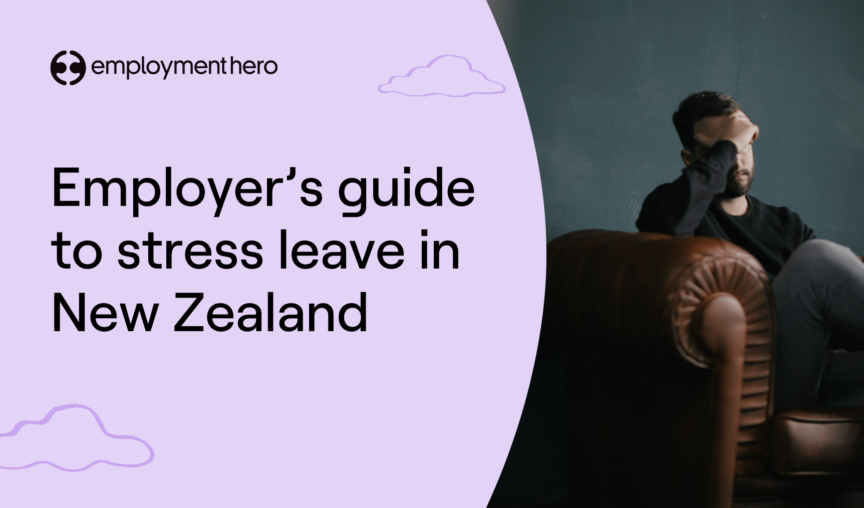
Nobody wants to be stressed at work but unfortunately, it’s pretty common. According to our Wellness at Work report, over half of New Zealand workers reported burnout at their jobs. Managing workplace stress as an employer can be really complicated and challenging but it’s not just a moral imperative, it’s a legal one too.
In our guide to stress leave and workplace stress, we’ll go over what stress leave can look like, what obligations you have as an employer and how best to manage workplace stress. Here’s to happier, healthier New Zealand workplaces.
What is stress leave?
Stress leave is an optional type of leave that employers may offer their employees in the incidence of workplace stress. Whether this leave is available, and if it is paid or unpaid, is entirely up to the employer.
It’s critical to note that while stress leave may be seen as a benefit that employers can offer employees, ideally a business would have no need for stress leave at all. Sensible management and correct workplace health and safety management should mitigate any risks before the need to access stress leave.
Is stress leave the same as paid sick leave?
No, unlike stress leave, sick leave is a legal requirement for eligible New Zealand employees when they’ve worked for an employer for a set period of time. Sick leave may be an option for an employee to take, should their workplace stress affect their mental or physical health. For many New Zealand employers, taking sick leave is likelier than taking stress leave, given its availability.
How long can an employee go on stress leave for?
The duration of stress leave is completely up to the discretion of the employer. Otherwise, they’d have to use their sick leave allowance.
For sick leave, all employees (including part-time and casual employees) are entitled to 10 days of paid leave per year, if:
- They have six months of current continuous service with the same employer, or
- They have worked for the employer for six months for:
- An average of 10 hours per week, and
- At least 1 hour in every week or 40 hours in every month.
Should an employee not be eligible or has run out of their sick leave entitlement, they can ask for leave in advance, use annual leave or ask to take unpaid leave.
What are some main causes of workplace stress?
Workplace stress can be caused by a number of factors, such as:
- Workplace bullying
- An workload that exceeds what is reasonable
- A hostile or toxic work environment
- Harassment
- Limited health and safety precautions that cause risk
- Workplace restructuring and clear job insecurity
 Employer obligations and responsibilities
Employer obligations and responsibilities
While employers aren’t obligated to provide stress leave, all of these factors that may cause workplace stress fall under the responsibility of the employer. Mental health and stress is classified as a health and safety risk, and part of an employer’s workplace health and safety responsibilities. They must make reasonable efforts to mitigate these issues.
Likewise, as part of workplace health and safety, employees have a duty to report any workplace threat to their health and safety, which includes stress.
Take this recent legal case against The Warehouse Group, who were ordered by the Employment Relations Authority to pay a former employee $50,000 in compensation, after the worker experienced extreme burnout. According to the details of the case, the employee had raised his burnout and the excessive workload he was dealing with, but the company failed to manage and support his needs over an extended period of time.
What about employee stress unrelated to the workplace?
It’s important to note that employers are not required to take action in the event that an employee has stress unrelated to the workplace. However, as part of their workplace health and safety commitments, they should take reasonable measures to support their employee during working hours. That might involve allowing some flexible working hours or leave in advance.
In the case of bereavement or family violence, there are also specific leave types that the employer can offer if the employee is eligible – see our blogs on bereavement leave and family violence leave.
How does workplace stress affect employees’ mental health?
Workplace stress can have a huge impact on mental health. A New Zealand study by Healthify found that young workers who were exposed to workplace stress had twice the risk of depression or anxiety. These debilitating mental health issues can have a huge impact on an employee’s personal and work life.
It’s not just mental health either – the study found that ongoing stress can lead to physical health conditions, such as chronic headaches or heart disease. This can be directly caused by changes in a person’s body due to stress, or lifestyle habits used to cope with the situation, such as drug use or overeating.
It’s key to stress that while as an employer you have a legal obligation to mitigate risks to mental health, it’s also demonstrative of your moral stance and commitment to your employees on a personal level. Poor treatment of your employees will not only affect your bottom line and productivity, but your broader reputation.
Can employers ask for proof of workplace stress?
An employer can ask an employee who says they have workplace stress to see a doctor and be diagnosed. However, the employee is under no obligation to do so.
If the employee has taken sick leave to deal with stress, then the usual sick leave requirements apply. An employer can ask for a medical certificate if they have been sick for three or more consecutive days, although the certificate doesn’t need to specify anything beyond their unfitness for work.
 What are some measures that can be taken to prevent work-related stress?
What are some measures that can be taken to prevent work-related stress?
There are plenty of ways that employers can manage workplace stress. Those include:
- Supporting employees in controlling their pace of work.
- Matching job demands to employees’ skills and abilities.
- Having clear policies to prevent and address unacceptable behaviour – and acting on them if required.
- Creating clear communication channels for employees to raise concerns, such as 1:1s and surveys.
- Ensuring managers and team leaders can identify and support stressed employees appropriately.
- Encouraging your team to use their leave balances, so they get sufficient time away from work.
- Introducing flexible work arrangements.
- Regularly conducting workplace health and safety checks, including checking for mental health risks.
- Including employees in change processes, letting them contribute and considering their input.
- Provide training to employees so they understand their duty to inform their employer of any stress risks.
Manage your workplace health and safety risks with Employment Hero
We want all New Zealand employers to have a stress-free team who feel supported in the work they do. If you’re looking to manage stress at work, as well as your broader workplace health and safety risks, Employment Hero has the features you need to introduce many of the measures we’ve already suggested.
Employment Hero’s all-in-one platform makes managing people super easy, whether it’s approving that important leave so employees can have some much-needed time away, or facilitating strong communication channels across the company. We’ve also got a number of dedicated workplace health and safety features, so you can feel supported in meeting your obligations.
Plus, we’ve got a comprehensive policy library to manage any unwanted issues in case they arise, along with an easy acknowledgement tracker to ensure that all employees understand their responsibilities.
For more information about how Employment Hero can support your business, reach out to our team today.
Disclaimer: The information in this report is relevant as at 27 March 2024, and has been prepared by Employment Hero Pty Ltd ABN (11 160 047 709) (Employment Hero). The views expressed herein are general information only and are provided in good faith to assist employers and their employees. The Information is based on data supplied by third parties. While such data is believed to be accurate, it has not been independently verified and no warranties are given that it is complete, accurate, up to date or fit for the purpose for which it is required. Employment Hero does not accept responsibility for any inaccuracy in such data. To the maximum extent permitted by law, Employment Hero will not be liable to any party in contract, tort (including for negligence) or otherwise for any loss or damage arising either directly or indirectly as a result of reliance on, use of or inability to use any information provided in this report. Where liability cannot be excluded by law then, to the extent permissible by law, liability is limited to the resupply of the information or the reasonable cost of having the information re-supplied.


